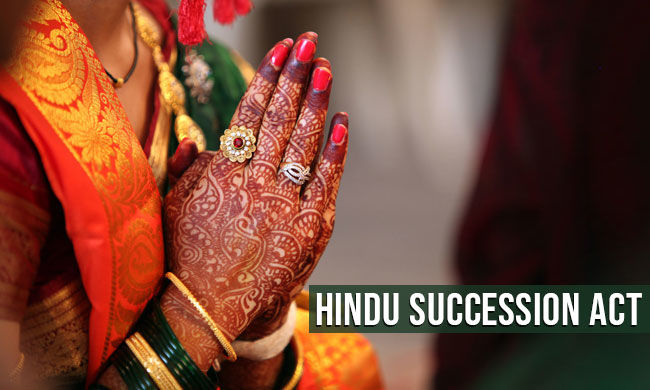This article has been written by Ishaan Banerjee and Monesh Mehndiratta. This article gives an overview of the Hindu Succession Act, 1956 and explores who can get property by succession and in what order. The article gives the features of the Act and further explains the devolution of property on the basis of succession.
This article has been published by Sneha Mahawar.
Table of Contents
Introduction
The Hindu Succession Act, 1956 is an Act relating to the succession and inheritance of property. This Act lays down a comprehensive and uniform system that incorporates both succession and inheritance. This Act also deals with intestate or unwilled (testamentary) succession. Therefore, this Act combines all the aspects of Hindu succession and brings them into its ambit. This article shall further explore the applicability, and the basic terms and definitions and the rules for succession in the case of males and females.
The rules of Hindu personal law are heavily dependent on the two schools popularly known as Mitakshara School and Dayabhaga School. According to the Mitakshara School, there are two modes of devolution of property. These are:
- Devolution by survivorship
- Devolution of succession
The rule of survivorship is only applicable with respect to joint family property or coparcenary property. On the other hand, succession rules apply to separate property held by a person. However, the Dayabhaga school places emphasis on succession as the only mode of devolution of property. The article discusses the rules of succession under the Act and gives an overview of the whole Act. It also describes the devolution of coparcenary property along with the major changes brought by it.
Applicability
Section 2 of this Act lays down the applicability of this Act. This Act is applicable to:
- Any person who is Hindu by religion or any of its forms or developments, including a Virashaiva, Lingayat, or a Brahmo, Prarthna or Arya Samaj follower.
- Any person who is a Buddhist, Sikh, or Jain by religion.
- Any other person who is not a Muslim, Christian, Parsi, Jew, unless it is proved that such person would not be governed by Hindu law or custom.
- This Act shall also extend to the whole of India.
However, this Section shall not apply to any Scheduled Tribes covered under the meaning of Article 366 of the Constitution, unless otherwise directed by the Central Government by notification in the Official Gazette.
Who qualifies as a Hindu, Sikh, Jain or Buddhist
- A legitimate or illegitimate child, where both of his parents are either Hindus, Buddhists, Jains or Sikhs.
- A legitimate or illegitimate child, one of whose parents is a Hindu, Buddhist, Jain or Sikh and is brought up as a member of the tribe, community, group or family to which such parent belongs.
- Any person who is a convert or reconvert to the Hindu, Sikh, Jain or Buddhist religion.
Basic terms and definitions
Agnate
Section 3(1)(a) defines ‘agnate’. A person is said to be an agnate of another if the two are related by blood or adoption wholly through males.
Cognate
Section 3(1)(c) defines a person to be a ‘cognate’ of another if such a person is related to the other by blood or through adoption but not wholly through males.
Heir
According to Section 3(1)(f), ‘heir’ is any male or female person, who is entitled to receive the property of the intestate.
Intestate
According to Section 3(1)(g), a person who dies without leaving behind a will is referred to as intestate.
Related
According to Section 3(1)(i), ‘related’ means the relationship between kin( kinship), which should be legitimate. Illegitimate children shall be deemed to be related to their mother and to one another, and their legitimate descendants shall be deemed to be related to them and to one another.
Which properties does this Act not apply to
Section 5 lays down the properties that this Act does not apply to:
- Any property whose succession comes under the regulation of the Indian Succession Act, 1925 by reasons of the provision under Section 21 of the Special Marriage Act, 1954. Section 21 of the Special Marriage Act states that succession to the property of any person whose marriage is solemnized under this Act and the property of the issue of such marriage shall be governed by the Special Marriage Act.
- Any estate or property which goes to the single heir through the terms of any agreement or covenant formed between the Ruler of an Indian State and the Government or through any enactment formed and passed before the commencement of this Act.
- The Valliamma Thampuran Kovilagam Estate and the Palace Fund are under the administration of the Palace Administration Board due to the powers conferred under the Proclamation (IX of 1124), dated 29th June 1949, given by the Maharaja of Cochin.
Features of the Act
The importance of the Act lies in the fact that it provides uniform rules for succession and reduces the conflict that arose due to confusion over different rules based on the ideas of two schools. Other features of the Act are:
- It makes a uniform system of inheritance and devolution of property that is equally applicable to areas of Mitakshara and Dayabhaga school. The applicability of the Act is explained thoroughly under Section 2 of the Act. However, it does not apply to people governed by the Special Marriage Act, 1954.
- Another important feature of the Act is its overriding effect given under Section 4. It abrogates all the earlier laws, customs, rules, etc that were applicable to Hindus with respect to succession. Any Act or law that is inconsistent with the provisions of this Act will be ineffective.
- It has also abolished the concept of impartible estate and its succession by special mode.
- Earlier, the rule of survivorship in coparcenary property was only applicable to male heirs. Female heirs were not recognised and given the right to inherit by survivorship. But after the enactment of the Act, there has been a change in this concept. Now, if a male dies intestate, leaving behind a female heir, the property would devolve according to the provisions of this Act and not the rule of survivorship.
- The Act provides order of succession based on the doctrine of propinquity, i.e., nearness or closeness of blood, and gives four different categories that are:
- Class I heirs
- Class II heirs
- Agnates (people related to each other either by blood or adoption only through males)
- Cognates (people related to each other either by blood or adoption but not through males)
- The rules of succession are different for the property of males and females. In the case of a male who dies intestate, Class I heirs are usually given preference over Class II heirs, and Class II heirs are further preferred over any other heirs.
- The Act further abolished the limited estate of women, and she is now the absolute owner of her property, irrespective of its source. Earlier, she was a limited owner, and the rights to her property were exercised by her husband, but now all the rights are exercised by her, and she can even dispose of her property and take decisions.
- The Act also recognises the right of a child in the property who is in the mother’s womb. (Section 20) It states that an unborn child in a woman’s womb would have the right to inherit the property, assuming that he has been born before a person dies intestate.
- The Act also clarifies that full-blood relations are preferred over half-blood relations under Section 18. It further explains the concept of shares that are to be divided per capita or per stirpes (division of shares in which share is given to a branch of heirs as a whole) and such heirs inherit property as tenants in common. (Section 19)
- It gives a list of people that are excluded from inheriting a property on different grounds. However, it abolished all the grounds that excluded a person due to his physical deformity or capability under Section 28. It also provides that the right of an illegitimate child to inherit property is confined to the mother’s property and not the father’s property.
Devolution of interest in Coparcenary property
Coparcenary is a concept that consists of those people in a Hindu joint family who inherit or have a common legal right to their ancestral property. Such people are called coparceners. These are the descendants of a common ancestor, and they acquire their right to joint property by birth. The Act also provides for the devolution of interest in coparcenary property, and there has been a change in the position with respect to coparcenary property due to the Hindu Succession (Amendment) Act, 2005. This is discussed in detail below.
Before Amendment
As mentioned earlier, the Mitakshara school recognises two modes of devolution of property, i.e., by survivorship and by succession. The rule of survivorship applies to coparcenary property, while succession applies to the separate or self-acquired property of a person. Coparcenary property is an ancestral property of a Hindu joint family and consists of:
- Property inherited by a person from their ancestors,
- Any property whose acquisition was done by the coparceners with the help of ancestral property,
- Joint acquisition by coparceners,
- Separate property of coparceners as common stock.
The concept of coparcenary ceases to exist once a partition is done in a Hindu joint family. Section 6 of the Act provides for the devolution of interest in coparcenary property. Before the Amendment of 2005, if a person died intestate, i.e., without making a will, his interest in the coparcenary property would be governed and devolved according to the rule of survivorship and not succession. It further prescribed that if a person who died intestate left female heirs mentioned in Class I, then the rules of succession would be applicable, which means that the rule of survivorship was not applicable to female heirs nor did they inherit property if male heirs were present.
For example, if A person X dies intestate, leaving behind his two sons, B and C, and a daughter, D. His undivided share would devolve on B and C according to the provision before the amendment. In the case of Satyendra Kumar v. Shakuntala Kumaru Verma (2012), the court held that if a person or coparcener gifts his undivided share in a coparcenary property as a gift and there is no evidence to show the completion of partition, such a gift will be void.
After amendment
The position of the law with respect to coparcenary property has changed since the 2005 amendment. It is now a well-established law under Section 6 of the Act that daughters are coparceners by birth and have the same and equal rights as sons. She has all the rights to inherit coparcenary property like a son and would also have to fulfil the liabilities. All of this is applicable after the commencement of the amendment Act. However, there will be no change in any devolution done before 2004.
It also provides that such a property inherited by a female will be her own property, and she will be an absolute owner and not a limited owner. It further states that a coparcenary property will be devolved assuming that a partition has taken place with respect to such property, in which the daughters will receive the same share as given to the sons. The Court, in the case of Ramesh Verma v. Lajesh Saxena (2017), held that the rules of succession will be applicable to separate property acquired by a person on division by notional partition.
The Madras High Court clarified that unmarried daughters are coparceners by birth and must be treated equally with sons and hence be given an equal share like him. The Amendment Act also provides that the right of married girls to seek partition is an absolute right and is not restricted by any limitation (Nagammal v. N. Desiyappan, 2006). The Supreme Court in one of the cases held that the rights of daughters as coparceners under the 2005 amendment were not limited to their date of birth. They are entitled to be coparceners irrespective of their birth date (Prakash v. Phulavati, 2016).
Types of succession
Testamentary Succession
When the succession of the property is governed by a testament or a will, then it is referred to as testamentary succession. Under Hindu law, a Hindu male or female can make the will for the property, including that of a share in the undivided Mitakshara coparcenary property, in favour of anyone. This should be valid and legally enforceable. The distribution will be under the provisions of the will and not through the laws of inheritance. Where the will is not valid, or not legally enforceable, then property can devolve through the law of inheritance.
Intestate Succession
Intestate has already been defined above as someone who dies leaving behind no will or testament. When such a situation happens, then this property will be distributed among the legal heirs by following the laws of inheritance.
Rules for ownership in the case of males
Section 8 lays down the general rules for succession in the case of males. Section 8 applies in cases where succession opens after the commencement of the Act. It is not necessary that the death of the male Hindu, whose property has to be devolved by inheritance, should take place after the commencement of this Act. For example: if a father, during his lifetime, settles his property in favour of his wife and after the death of his wife, wishes that it should pass to his daughter, and the daughter dies after the commencement of this Act, then the succession will open and the property would devolve according to Section 8.
Classification of heirs
Heirs are classified into four categories:
- Class I
- Class II
- Class III (Agnates)
- Class IV (Cognates)
Class I heirs
- Sons
- Daughters
- Widows
- Adopted sons
- Mothers
- Sons of a predeceased son
- Widows of a predeceased son
- Son of a predeceased son of a predeceased son
- Widows of a predeceased son of a predeceased son
- Daughter of a predeceased son
- Daughter of a predeceased daughter
- Daughter of a predeceased son of a predeceased son
- Son of a predeceased daughter
- Daughter of a predeceased daughter of a predeceased daughter
- Son of a predeceased daughter
- Son of a predeceased daughter of a predeceased daughter
- Daughter of a predeceased daughter of a predeceased son
- Daughter of a predeceased son of a predeceased daughter
All of them will inherit simultaneously and even if any of them is present, then the property will not go to the Class II heirs. All Class I heirs have absolute rights in the property and the share of a Class I heir is separate, and no person can claim a right by birth in this inherited property. A Class I heir cannot be divested of his/her property, even by remarriage or conversion, etc.
Until the Hindu Succession (Amendment) Act, 2005, the Class I heirs consisted of twelve heirs, eight of which were females and four were males, but after 2005, four new heirs were added, of which eleven are female and five are male.
Now we will observe who classifies as son, mother, daughter or widow and what kind of interests they have in the property.
Son
The expression ’son’ can include both a natural-born son or adopted son but does not include a stepson or illegitimate child. In Kanagavalli v. Saroja AIR 2002 Mad 73, the appellants were the legal heir of one Natarajan. Natarajan was earlier married to the first respondent, the second respondent was the son and the third respondent was the mother of Natarajan. The first respondent obtained a decree of restitution of conjugal rights but still no reunion occurred between them. The first appellant claimed to have married Natarajan in 1976 and the appellants 2 to 5 were born through them. Natarajan died afterward. The suit was filed for declaration that the appellants were the legal heirs of the said Natarajan along with respondents 1 to 3, and they were entitled to the amounts due from the Corporation where Natarajan worked. The Court held that a son born of a void or voidable marriage that is declared to be annulled by the Court will be a legitimate child and would thus inherit the property of his father. A son has an absolute interest in the property and his son cannot claim birthright in it. Therefore, ‘son’ does not include a grandson, but does include a posthumous son.
Daughter
The term ‘daughter’ includes a natural or adopted daughter, but not a stepdaughter or illegitimate daughter. The daughter of a void or voidable marriage annulled by the Court would be a legitimate daughter and thus would be eligible to inherit the father’s property. The daughter’s marital status, financial position, etc is of no consideration. The share of the daughter is equal to that of the son.
Widow
The widow gets a share that is equal to that of the son. If there exists more than one widow, they collectively take one share that is equal to the son’s share and divide it equally among themselves. This widow should have been of a valid marriage. In the case of Ramkali v. Mahila Shyamwati AIR 2000 MP 288, it was held that a woman who was in a voidable or void marriage, and that marriage was nullified by the Court on the death of the husband, would not be called his widow and would not have rights to succeed to his property.
If the widow of a predeceased son, or the widow of a brother has remarried, then she shall not be given the term of ‘widow’, and will not have the inheritance.
Adopted son
The Act has clearly clarified the position of sons with respect to succession. He has been given all his rights as of the date the Act was enacted. Before the amendment of 2005, he was preferred over daughters and was eligible to be a coparcener but after the amendment, even the daughters are given equal rights. The question that arises now is whether an adopted son has any right to inherit property. This question has been amicably addressed by the Act. The explanation to Section 6(4) of the Act clearly states that a son, grandson, or great-grandson includes a son who was born or adopted before the commencement of the Amendment Act of 2005. This also means that an adopted son is treated the same as a natural son under the Act and has all the rights given to him.
Class II heirs
The Class II heirs are categorized and are given the property in the following order:
- Father
- Son’s Daughter’s son
- Son’s daughter’s daughter
- Brother
- Sister
- Daughter’s son’s son, daughter’s son’s daughter, daughter’s daughter’s son, daughter’s daughter’s daughter
- Brother’s son, sister’s son, brother’s daughter, sister’s daughter
- Father’s father, father’s mother
- Father’s widow, brother’s widow
- Father’s brother, father’s sister
- Mother’s father, mother’s mother
- Mother’s brother, mother’s sister
If no one from the Class I heirs takes the property, then Class II heirs fall in line to get the property. In Kalyan Kumar Bhattacharjee v. Pratibha Chakraborty AIR 2010 (NOC) 646 (Gau), the property fell into the share of the defendant’s brother named Ranjit, who was unmarried. However, he became traceless and the property was divided amongst two other brothers in equal shares. The plaintiff’s brother called Jagadish then executed a will in favour of both the plaintiff and died afterward. However, the defendants then asked them to vacate the land, contending that inter alia that the land has been purchased in the name of three brothers; namely Jagadish, Ranjit and Kalyan, defendant number 1. It was held that when a Hindu male is unmarried and he dies, and is not survived by a Class I heir, the Class II heirs would get the property.
Similarly, when in heirs in Class III and IV are there, the property would only go to them if no one from Class II is present.
Class III heirs
This consists of the agnates of the deceased. Class III heirs only inherit the property when none from the earlier classes gets the property.
An agnate is a person who is related to the intestate only through male relatives. An agnate can be a male or a female.
Rules of preference among agnates
- Each generation is referred to as a degree. The first degree is intestate.
- Degrees of ascent mean ancestral or upwards directions.
- Degrees of descent means in the descendants or downward direction.
- Where an agnate has both ascent and descent degrees, each has to be considered separately.
- An agnate having a descent degree will be preferred over the one having an ascent degree.
- When two agnates have ascent and descent degrees, the one having a lesser number of ascent degrees will be preferred.
Class IV heirs
A cognate (Class IV) is someone who was related to the intestate through mixed relatives, in terms of sex. For example, an intestate’s paternal aunt’s son is his cognate, but his paternal uncle’s daughter will be an agnate.
Therefore, to sum up it can be said that the property of the Hindu male devolves in the following manner:
- First, to the heirs in Class I.
- Second, if there exists no heir of Class I, then it goes to Class II heirs.
- Third, if none from the Class I or II exists, then it goes to the agnates (Class III).
- Fourth, if no one from the earlier three classes exists, then it goes to the cognates (Class IV).
Persons disqualified from heirs
The Act abolished all disqualifications on the basis of physical deformities, mental capabilities, or morals and instead gave a new set of disqualifications. Prior to the amendment of 2005, remarriage was a ground of disqualification for:
- Intestate’s predeceased son’s widow,
- Widow of predeceased son of a predeceased son,
- Widow of a brother of intestate.
However, after the amendment, disqualification of heirs has been classified as:
- Disqualification due to murder
- Disqualification due to conversion
Disqualification due to murder
Section 25 of the Act disqualifies a murderer from inheriting the property of the person whom he murdered. He is treated as non-existent and is not considered a part of the line of descent (Nirbhai Singh v. Financial Commissioner, Revenue, Punjab & Ors., 2017). A murderer under the Section also includes a person who aids or abets such a crime.
Disqualification due to conversion
Section 26 of the Act disqualifies a person or his children born after conversion, who converts from the Hindu religion to any other religion. The only condition upon which his descendants are eligible to inherit is that they must be Hindus at the time of succession. Section 27 further gives the effect of disqualification and mentions that in case of any disqualification, the property would be inherited considering that the person disqualified died before the intestate.
Changes brought by Succession Act 1956
The Act has brought some major changes in the rules of succession of the property. One of those is the manner of devolution of property. It has provided a uniform system of devolution of a coparcenary property and self-acquired or separate property. The other changes are discussed below.
Sapinda relationships are abolished
The present law has made several changes, and among those, it abolished the previous Sapinda relations that used to inherit property out of love and affection. It has now mentioned the list of heirs and divided them into four categories. People mentioned in such categories like Class I heirs, Class II heirs, agnates and cognates are entitled to inherit the property.
Changes with respect to the Hindu joint family
Earlier, coparceners did not have any right to make a will with respect to their share or property. This right has now been recognised under Section 30. The rule of survivorship has been replaced by uniform rules of succession that are different for males and females. The Act also recognised the rights of daughters as coparceners and they would now have the same rights as sons.
Removal of various disqualifications
The previous law disqualified the following people from inheriting a property:
- Lunatics,
- Idiots,
- Unchaste widows,
- Disqualifications based on physical deformities, etc.
However, such disqualifications have been abolished now, and the only 2 disqualifications under the Act are being a murderer or a converted person.
Succession in the separate property of a propositus
The right of succession in the separate property of propositus i.e. a person who died, was not recognised earlier, but now, it is well established that Class I heirs can inherit the property of propositus in equal proportion simultaneously with the succession in joint property. These Class I heirs are preferred over Class II heirs, and they cannot inherit if Class I heirs are present. Similarly, Class II heirs are preferred over agnates, cognates, and so on.
Changes with respect to illegitimate sons
An illegitimate son can only inherit his mother’s property but not his father’s property. He has not been given any rights in coparcenary property. His position was earlier chaotic due to the two schools and varied from caste to caste.
Changes in consanguine and uterine blood relations
Uterine blood relations were not recognised under the previous law and rules, but consanguinity had its recognition. Uterine relations are those where there is a common ancestress but different husbands. Under the present law, both relationships are recognised and given rights accordingly.
Other changes
The other changes are:
- Women are absolute owners of their property rather than limited owners.
- Earlier, the benefit of the doctrine of representation was given only to sons, grandsons, great-grandsons or pre-deceased sons. But it extends to daughters as well.
- The Act abolished impartible estate and its succession.
- It abolished the disqualification based on remarriage.
- It is not applicable to people governed by the Special Marriage Act, 1954.
- It has removed any kind of difference between male and female heirs.
Rules for ownership in the case of females
With the coming of The Hindu Succession Act, 1956, women are granted ownership of property, whether it was acquired before or after the commencement of the Act, thus abolishing their ‘limited owner’ status. But it was only in the Hindu Succession (Amendment) Act, 2005 that it was decided that daughters would be entitled to an equal share in the property as the son. Therefore, the 2005 Amendment serves as a defender for female rights.
The property in case of a female Hindu intestate dying will devolve through:
- Firstly, through the sons and daughters, which would also include the children of a predeceased son or a predeceased daughter) and the husband.
- Secondly, on the heirs of the husband.
- Third, upon the mother or the father.
- Fourth, on the father’s heirs.
- Fifth, on the heirs of the mother.
In the case of any property being inherited by a female Hindu by her father or mother and there is no son or daughter of the deceased (including a child of predeceased son or daughter), then it shall devolve in favour of the heirs of the father.
Similarly, in the case of any property being inherited by a female Hindu by her husband or her father-in-law, and there is no son or daughter of the deceased (including the child of a predeceased son or daughter), it shall devolve in favour of the heirs of the husband.
Conclusion
This article explored some basic terms and definitions used in the Hindu Succession Act, 1956. There are four classes of heirs to which property devolves in case if a Hindu dies leaving behind a will, in which case he becomes intestate. This property devolves through these classes. If no one from the earlier class is present, then it devolves to the next class and so on. Lastly, this article also explored the 2005 Amendment to this Act, which brought much-needed protection to women’s rights regarding the property.
The Act has been successful in bringing uniformity to the succession of property among Hindus. It tried to rectify all the loopholes that existed by enacting the 2005 amendment. However, there is an ambiguity as to people to whom this act is not applicable. One of the major impacts of this Act is that it emphasises equality between males and females by recognising the rights of daughters as coparceners. Women now have the right to be a coparcener, inherit property, be absolute owners, etc. The Act also abolished disqualifications based on the physical deformity and mental depravity and instead disqualified murderers and converted persons, which is reasonable.
Frequently Asked Questions (FAQs)
What is the difference between per stirpes and per capita succession?
In per stirpes succession, many heirs who belong to different branches get the share of the property given to their branch as a whole, while in per capita succession, the share of the property is given equally to the people of a branch.
What happens when two or more heirs succeed together?
When two or more heirs succeed and inherit the property of an intestate together, they inherit the property as per capita and not per stirpes and as tenants in common. (Section 19).
What is presumed in case of simultaneous death?
According to Section 21, in cases where two people die simultaneously and there is ambiguity as to who survived whom, it is presumed that the younger person between the two survived the other.
References
- https://www.thehindu.com/news/national/the-hindu-explains-what-is-coparcenary-property-in-hindu-law/article32364484.ece
- https://blog.ipleaders.in/coparcenary-hindu-law/
- https://www.scconline.com/blog/post/tag/coparcenary-property/
- https://evaw-global-database.unwomen.org/en/countries/asia/india/2005/the-hindu-succession-amendment-act-2005
- https://www.thehindu.com/opinion/editorial/right-by-birth-the-hindu-editorial-on-daughters-and-hindu-succession-act/article32347299.ece
Students of Lawsikho courses regularly produce writing assignments and work on practical exercises as a part of their coursework and develop themselves in real-life practical skills.
LawSikho has created a telegram group for exchanging legal knowledge, referrals, and various opportunities. You can click on this link and join:
Follow us on Instagram and subscribe to our YouTube channel for more amazing legal content.
 Serato DJ Crack 2025Serato DJ PRO Crack
Serato DJ Crack 2025Serato DJ PRO Crack

















 Allow notifications
Allow notifications



